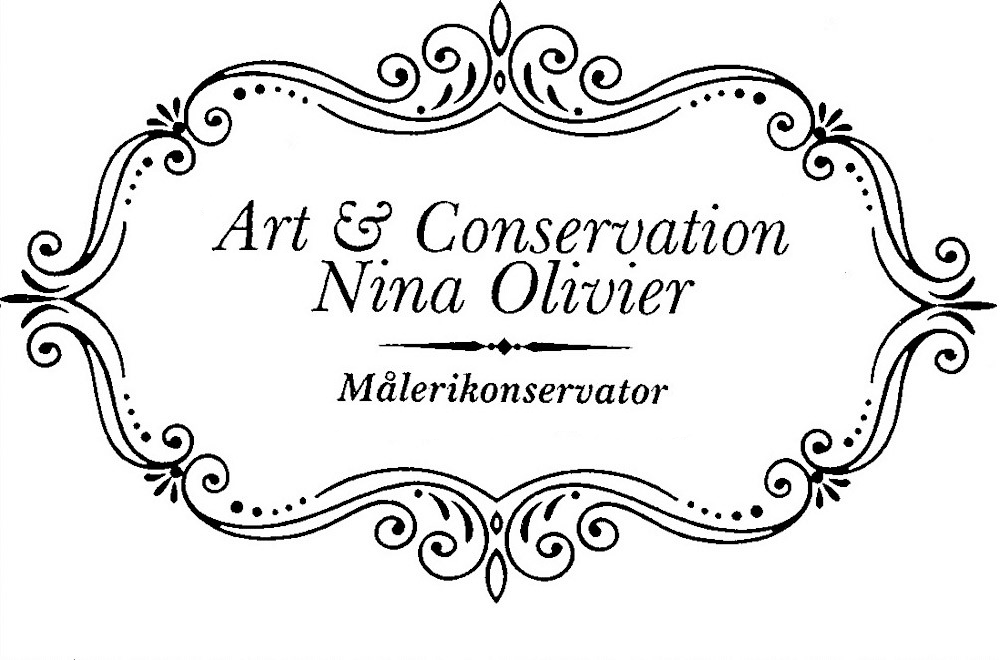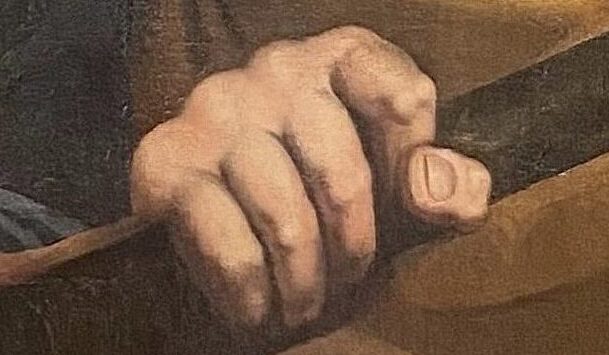Signature and textile report
EXAMINATION OF PAINT LAYERS
Portrait of Emperor Domitianus
JUNE 6, 2023

Object
Portrait of emperor Domitian
Owner
—
Examination of paint layers and identification of textile
Paint layers were examined via a hole mechanically made through a presumed signature by the present owner, as well as through a hole mechanically made close to the same signature area, also made by the present owner. Textile identification was made via a sample collected from the edge of the canvas by the conservator at the time of the examination.
Commissioner
—
Responsible for the examination
Nina Olivier, trained paintings conservator at the Gothenburg University, ordinary member of NKF-S and ICOM
Performed by
Nina Olivier, Art & Conservation AB
Introduction
Background and commission
Nina Olivier, Art & Conservation AB, was commissioned by owner, to perform an examination of the paint layers on a portrait of the emperor Domitian. The examination took place in May 2023 in the studio in Stockholm, where the portrait and the equipment were transported.
The commission consisted in examining the paint layers seen through a small hole made mechanically through a presumed signature of the painting by the present owners, in order to see the layers in the painting. There was also a wish to have the textile of the canvas identified.
Method
The examination of paint layers was conducted in the studio, ocularly, with an optical microscope and with a portable DinoLite microscope. The optical microscope was a work microscope with a Hayear 34MP Microscope Camera, a 90x enhancement and a 600x enhancement of the camera. It is owned by the commissioner and bought from China. The DinoLite used was an AF45-15-FVT device with 20x~220x enhancement, white light, Flexible LED control (FLC) and UV light.
The fiber from the canvas was examined through a microscope and compared with reference samples.
The portrait
The painting is a portrait of the Roman emperor Domitian. It is quite large, 133 x 102.5 cm. It shows the emperor in half figure, facing left. He is wearing a crown of laurel leaves and is dressed in Roman armor with a cape around his shoulders. In his right hand, he holds a fasces without the axe. In his left hand, we see the jewel embedded hilt of a sword. To the right upper part of the painting, the name DOMITIANO is seen in capital letters.
The painting is covered by a darkened and oxidized dammar varnish which is partially blanched. The painting has many darkened and discolored retouches. The varnish and the retouches result in a difficulty to fully see the image.
To the left lower corner, is a signature, “L dA Vinci, Pnixt”. The “Pnixt” is underlined, while the rest of the signature is not. The signature is not completely visible to the eye in normal light due to the overall darkness of the painting.
The painting
The painting is lined, retouched and varnished. There is no documentation on when the conservation treatments have been carried out nor by whom.
Provenance
According to the commissioner and a report written by — at —, the painting is part of a series of twelve portraits depicting the twelve first Roman emperors. The eleven first in the series are supposed to have been painted by Titian during the 1530’s, but the painter behind the twelfth portrait is unclear. The series is supposed to have been sold from England to the Spanish court in the 18th century and eventually disappeared in a fire, but according to the commissioner, there are question marks around this.
The painting was listed for sale at Christie’s in London on August 2nd, 1928 as lot 156, then again on December 10th, 1928 and again on June 7th, 1929. None of these times, the painting was sold.
It has been in the family of the commissioner for the past 85 years.
Examination
Ocular examination
Not much was possible to say through the ocular examination regarding paint layers or fiber identification, other than that the signature looks as if it has been partially removed in a previous conservation treatment. It is also clear that it is underneath the present oxidized varnish. The varnish is very thick and blanched and obscures the overall look of the painting.
DinoLite
The hole through the presumed signature was examined with a portable DinoLite AM7115MT-FUW microscope, using white light, raking light and UV light.
The surrounding light reflected a lot in the varnished surface, making it hard to distinguish the layers. But it was clear to see the thick varnish and the paint layer immediately underneath it. Also, the fibers from the canvases were visible, both in UV light and regular, white light.
Two or three other layers can be distinguished, between the paint layer and the canvas, but whether they are paint layers, ground or varnish is hard to see. No white ground is visible.
Microscopy
The microscopy was very sensitive, making focusing on the right area difficult.
Through microscope, the blanching of the varnish was visible.
The same layers were noted as with the DinoLite. Images taken with a UV light note a purple fluorescence of the paint layers, with a different fluorescence on the top paint layer from the underlying.
Layers
The layer sequence was determined by examining the hole through the presumed signature and images of it.
| Layer | Comment |
|---|---|
| Support 1: canvas | Lining |
| Glue | No tests have been done on the glue |
| Support 2: canvas | |
| Ground: red or brownish red | |
| Thicker red transparent layer | |
| Layer: yellow/beige | |
| Paint layer: brownish pink | |
| Paint layer: dark, probably black mixed with something else | Has grains of red and yellow |
| Varnish: dammar | Applied in several layers |
Fiber comparison
A fiber from the canvas was collected from the side of the painting and compared with a reference fiber sample. To ensure the correct canvas layer was examined, a fiber was taken from directly underneath the paint layer.
The fibers were examined in a Lotus WF10X microscope with a 10x enhancement, in white light. Pictures were taken with a cellphone camera through the ocular.
The reference sample held a linen fiber. The reference sample shows an organic plant fiber, long, straight and with “knees”. The sample fiber from the painting has been pre-sized and treated and therefore looks a bit different to the reference fiber, but it also seems to be an organic plant fiber,
which is long and straight.


Summary and conclusion
The painting was investigated ocularly, with an optical work microscope and with a portable DinoLite microscope, in both white light, raking light and UV light. Reflections from surrounding light made it hard to see and focus on the layers.
Also, since the hole was so small, determining layers in the hole was difficult.
Some layers however, could be spotted;
Support 1, canvas, lining
Glue, although this layer was not possible to fully distinguish during this examination, it must still be
present as the painting is lined.
Support 2, canvas
Ground: red or brownish red. No white ground was found.
Layer: yellow/beige
Paint layer: brownish pink
Paint layer: dark, possibly black mixed with something else. Has grains of different colors; red, yellow.
In order to fully determine the layers, a cross section should be made. However, as the area of investigation is sensitive, no cross section is recommended through this area of the painting.
A more suitable place to collect a sample would be from the side of the painting.
A fiber taken from the canvas of the painting was compared with a reference fiber of linen through a microscope. The fiber from the canvas has been pre-sized and treated, and therefore looks differently from the reference sample. Regardless of that, the fiber from the canvas seems to be an organic plant fiber, long and straight, just as the reference fiber. A cotton fiber would have been twisted. A conclusion is therefore that the canvas of the painting most likely is linen.







